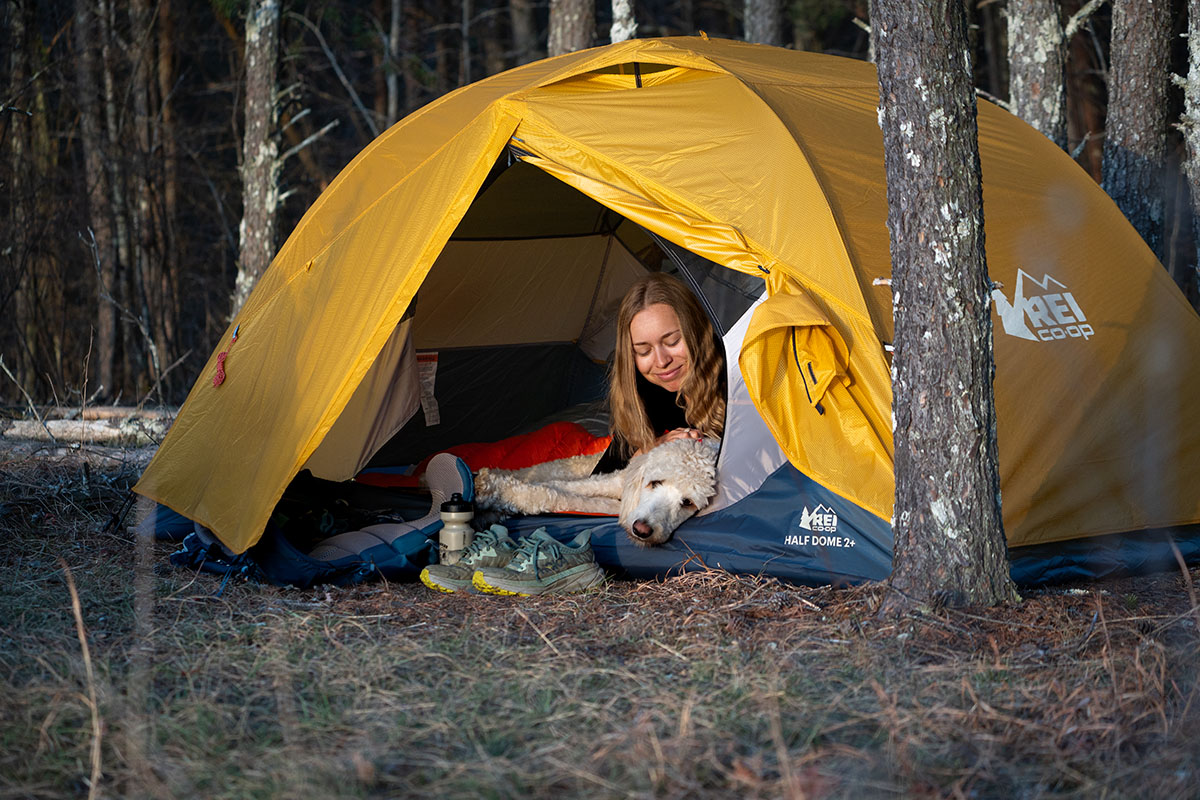
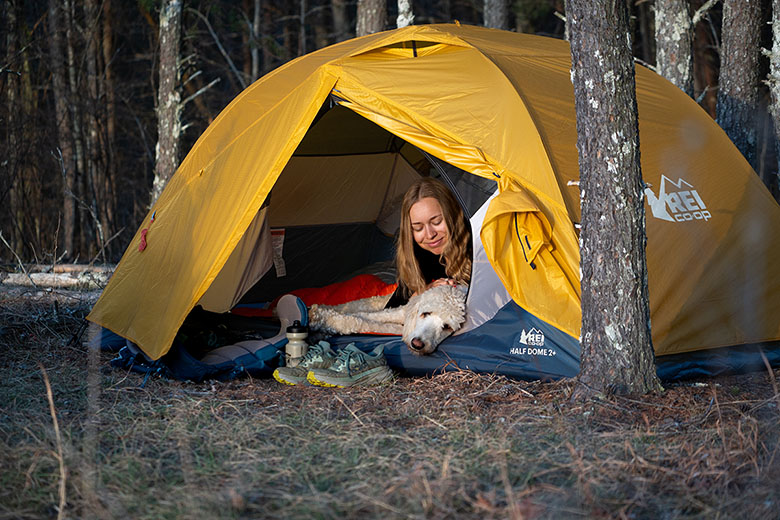
Chris Carter


Chris Carter
Price: $359
Packaged weight: 6 lb. 3.6 oz.
Floor denier: 75D
Capacities: 2, 2+, 3P
What we like: Well built, easy to use, and tons of room at a good price.
What we don’t: Heavy for backpacking, tough to pack, and not the most refined storage layout.
See the REI Co-op Half Dome 2 Plus
Beloved by backpackers for years, REI Co-op’s Half Dome received some notable updates this year: The latest version uses thicker fabrics, boasts a larger floor area, and features an updated pole design to provide even more head and shoulder room. I tested this update on a backpacking trip in Tennessee’s Cumberland Plateau area and found it to be extremely roomy, easy to set up, and well equipped to handle the rigors of backcountry use. In fact, it proved to be the ideal home base for my partner and me, as well as our large, high-energy dog. Below I break down my experiences with the latest Half Dome 2 Plus. To see how it stacks up to the competition, see our articles on the best backpacking tents and best budget backpacking tents.
Editor's note: This review was updated on May 9, 2025, following our hands-on testing of the latest Half Dome 2 Plus. We refreshed all product information, including our performance insights, and updated the photos to reflect the newest model.
As the “plus” in its name suggests, the latest REI Co-op Half Dome 2 Plus is roomier than many competitors, making it a standout option for backpackers looking for a little extra space to sprawl out, organize gear, or bring along a pet. In fact, the latest update increased floor area to a generous 35.8 square feet—up from 33.7 square feet in the prior version. Compared to the standard Half Dome 2, the 2 Plus offers 4 additional square feet of space but costs $60 more. That said, when you compare interior livability to cost, the 2 Plus outperforms much of the backpacking tent market. For example, our top-ranked tent this season, the Big Agnes Copper Spur UL2, has a smaller 29-square-foot floor area and costs a significant $190 more than the Half Dome, although it's much lighter at 3 pounds all in (more on this below).

The Half Dome 2 Plus feels every bit as roomy as REI claims. My partner and I easily fit ourselves, all of our gear, and our large dog inside without any trouble. The 42-inch peak height makes it easy to sit up and move around, while the vertical mesh side walls enhance the feeling of spaciousness. With a 56-inch width, two standard sleeping pads fit side by side with extra room for gear. As a tall person (6'2"), I really appreciated the boost in livability—something few other two-person backpacking tents can match.

Considering the generous living space, it comes as little surprise that the Half Dome 2 Plus lands on the heavy end compared to most backpacking tents. With a packed weight of 6 pounds 3.6 ounces (REI claims a minimum trail weight of just over 5 pounds), the 2 Plus is about 4.5 ounces heavier than the standard Half Dome 2. You can go even lighter with a design like MSR’s Hubba Hubba LT 2P (3 lb. 6 oz.) or the aforementioned Copper Spur UL2 (3 lb.), but those tents are much pricier than the Half Dome and come with sacrifices in durability and livability. Within the sub-$350 category, very few tents can match the Half Dome's combination of weight and roominess.

Packed size nearly always goes hand-in-hand with weight, so it’s not surprising that the Half Dome measures a fairly large 7.5 by 22.5 inches. One of the culprits that increases the bag’s diameter is the single-hub pole design, which is bulkier when broken down than tents that come with multiple poles. Between the weight and the tough packability, this Half Dome has limited backcountry appeal, and I'd go so far as to call it a camping/backpacking crossover. Then again, it depends on your objective: Casual backpackers looking to hang out at a scenic camp spot might find the hefty weight worth the livability, but dedicated backpackers will likely appreciate the reduced heft and improved packability of a lighter and more compressible tent.
Backpacking gear always requires some care, but the REI Co-op Half Dome 2 Plus is among the tougher tents on the market. The latest update makes it even more durable, with a thicker 75-denier (D) floor and 40D rainfly (compared to the previous version’s 40D floor and 30D rainfly). While this upgrade adds some weight, the trade-off in durability is worth it, in my opinion. The tent fabric has held up well so far in testing, including some serious abuse from my 60-pound dog who tried to jump through the mesh door, leaving only a small hole in the 20D fabric. The included footprint (75D) adds another layer of protection or can be left behind to save a bit of weight. The rest of design follows suit: All zippers slide smoothly, the aluminum poles are sturdy, and the rainfly buckles seem adequately sturdy. Taken together, the Half Dome is extremely hardwearing, and I expect it will last me several seasons to come.
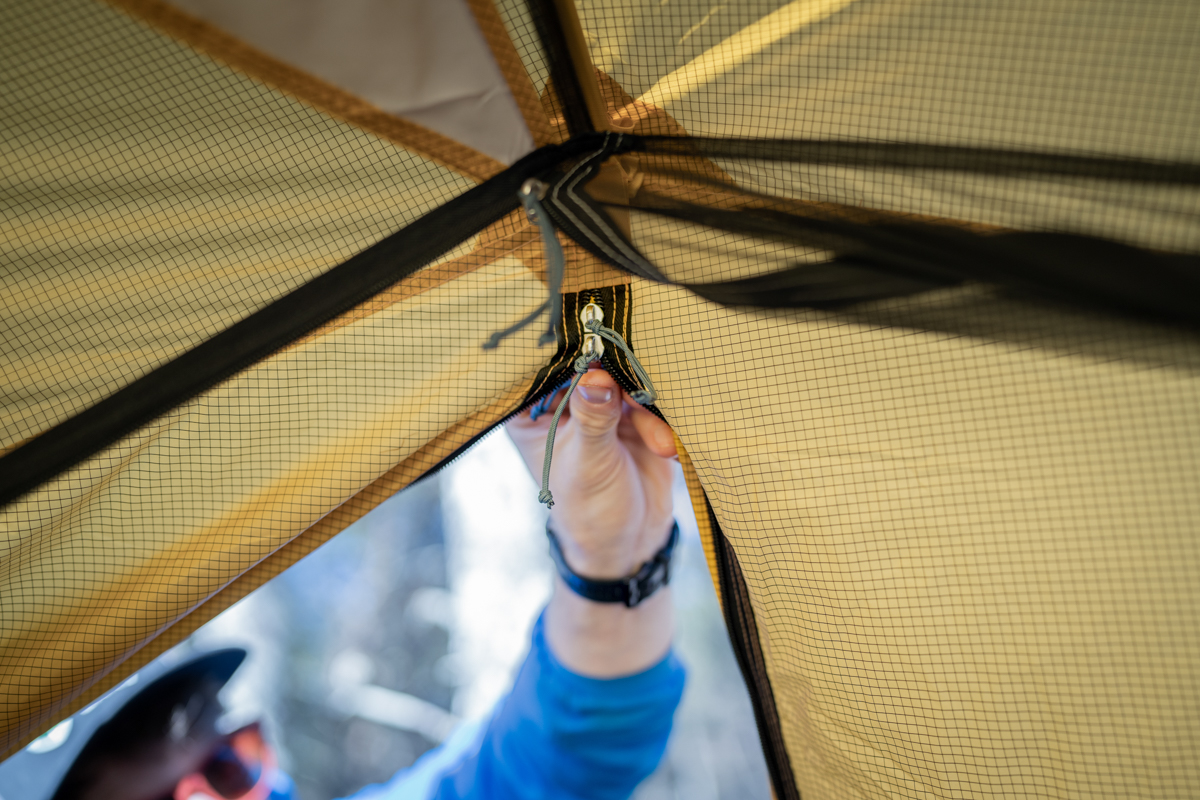
The Half Dome 2 Plus is equipped to handle most 3-season conditions with its sturdy, freestanding construction, full-coverage rainfly, and raised bathtub floor with quality seam taping. The previous version held up well to rain, light wind, and sleet, and while we have yet to camp in any truly nasty weather in the latest model, we have very few worries that the outcome will be any different. In fact, the thicker fabrics should provide an even more stalwart defense against precipitation. However, it’s worth pointing out that the height of this tent will likely leave it susceptible to high winds. To increase weather-worthiness, it’s wise to pack extra stakes to guy it out (10 are included).
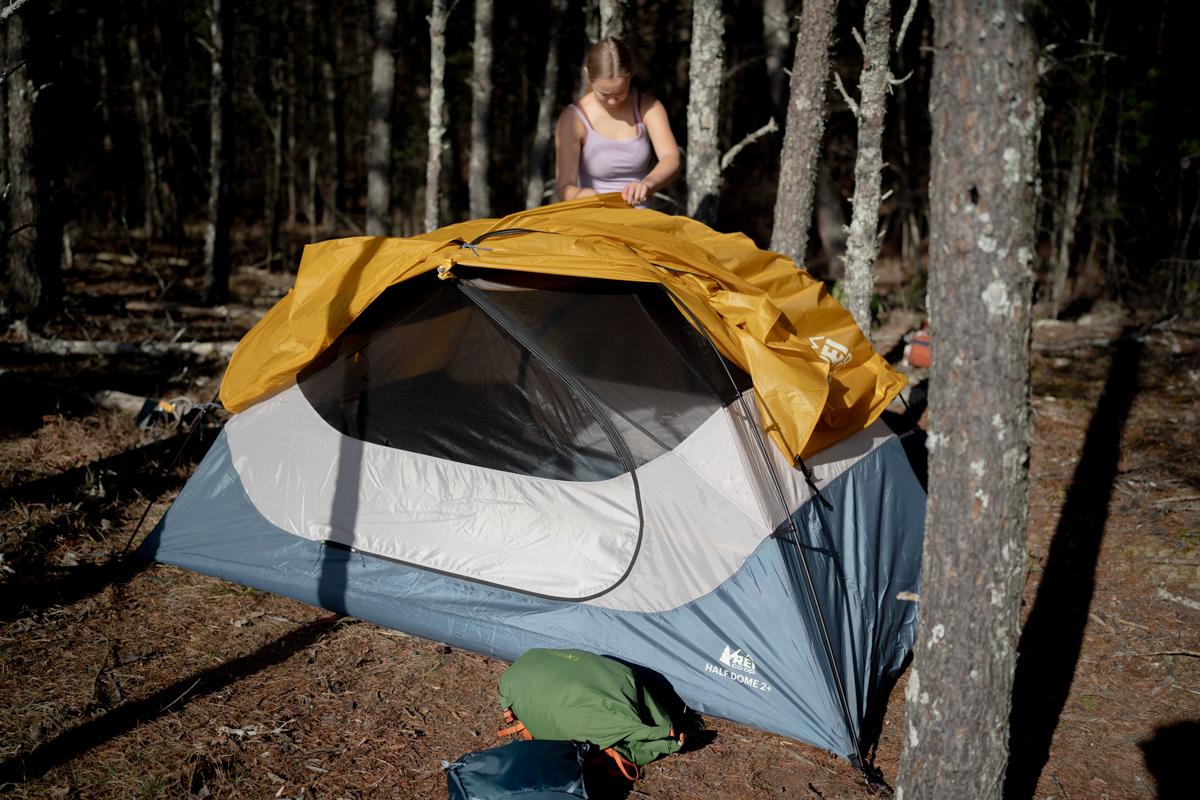
With large vents, lots of mesh, and enough space separating the rainfly and tent body, the Half Dome 2 Plus is a great ventilator. The vents are nicely designed and easy to access right over the side doors, providing good airflow into the inside of the tent. In testing, I found I was able to customize ventilation easily depending on weather conditions: Open up the fly for more airflow inside the tent, or zip it down to batten down the hatches when the temperatures drop. In the 50-degree March weather on the Cumberland Plateau, ventilation was key to keeping condensation to a minimum throughout the night.
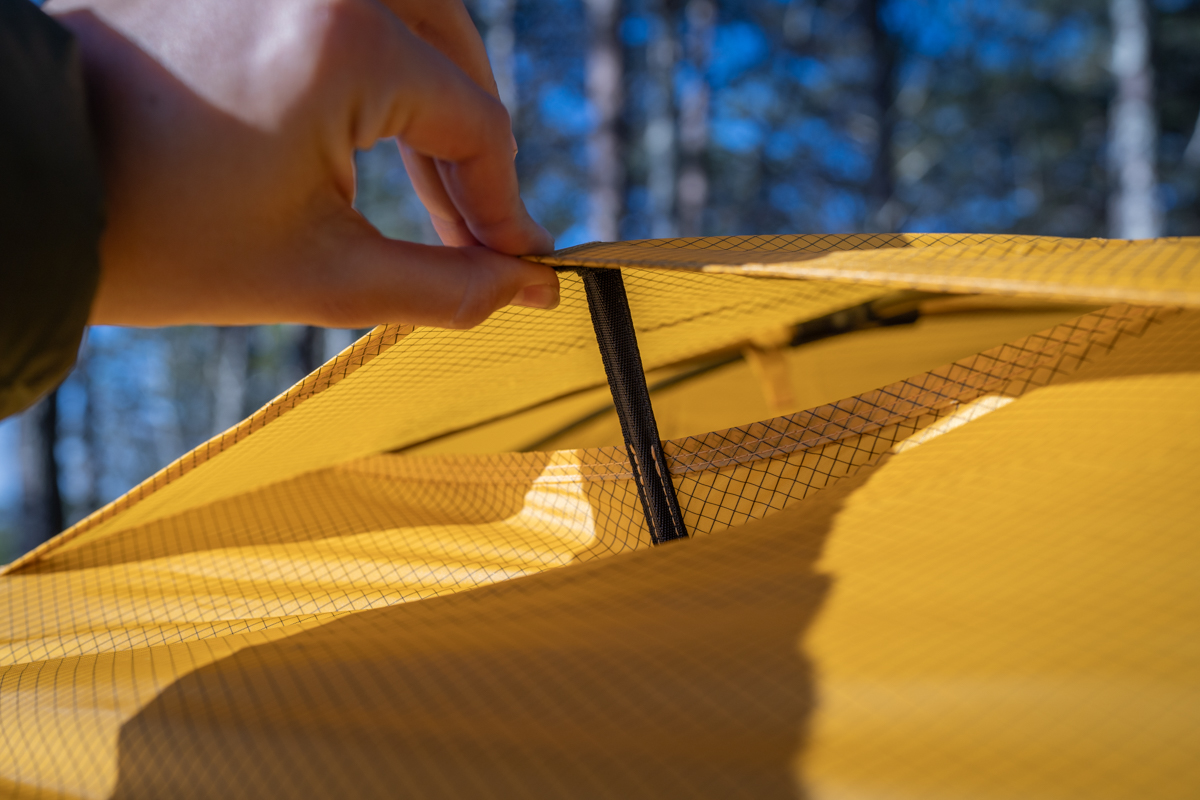
The Half Dome’s two-door-and-vestibule design means it’s easy for two people to store their packs, hiking boots, and other gear on either side of the tent with plenty of room for entry and exit. Each vestibule has 9.6 square feet of storage space, and the zipper design on the fly (which opens to the side and down) creates a wide opening for getting in and out of the tent. The rainfly can be rolled up and secured out of the way for increased airflow or stargazing, as well.
That said, I found the interior storage layout to be a bit lacking. On paper, six interior mesh pockets seems like more than enough, but in practice, I found the pockets small and poorly situated. For instance, the large mesh pocket is positioned on the side of the tent, making it hard for both campers to access it easily. However, there is one thoughtful pocket detail that I appreciated more than most: The light-diffusing pocket on the ceiling of the tent made headlamp light softer, creating a nice ambiance for nighttime reading or card games.

The Half Dome 2 Plus' freestanding design is very intuitive to set up, and the single hub connecting the poles eliminates any guesswork. The color-coded poles are easy to line up correctly (with the gold ridge pole across the middle of the tent), and then it’s as simple as connecting the four corners, clipping it all together, and securing the ridge pole. The footprint comes connected to the tent body for even easier assembly, but removing it is also a simple process. Adding the rainfly is just as painless, although we did find that it’s a good idea to connect the ridge pole’s grommets before buckling the rainfly into the bottom, which keeps from having to strain to make it fit. Though I found the process easy to master, the tent bag includes a helpful guide for those just getting started.
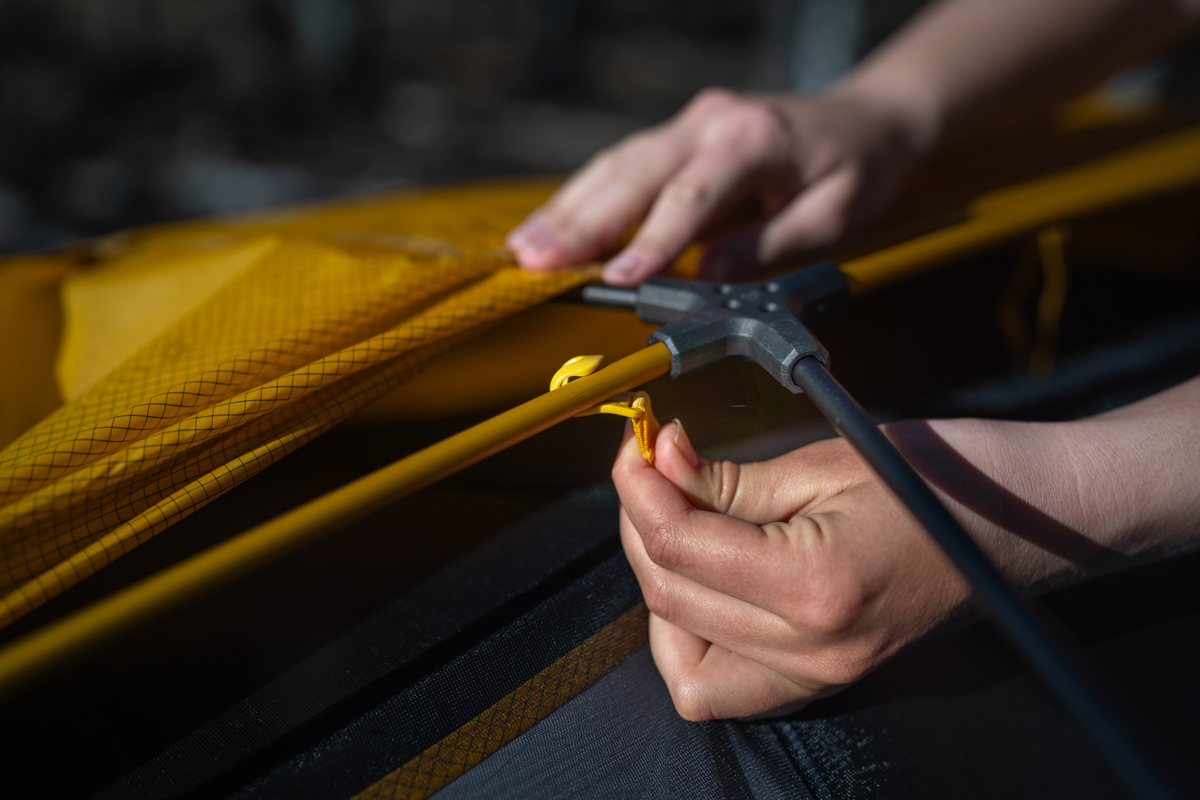
While disassembling the tent was just as simple, I did struggle with stuffing the tent back into the bag. The thick materials don't compress down well. Packing the poles separately helped, but in the end, I found it more efficient to stuff the tent in my backpack outside of the bag.
There's been big push for more sustainable manufacturing processes in the outdoor industry over the last several years, and the REI continues to be a leader in this realm. In this case, the Half Dome 2 Plus employs a nonflourinated durable water-repellant (DWR) coating on the rainfly—which forgoes the use of harmful “forever chemicals”—and solution-dyed mesh, which uses less energy than conventional dyeing processes. REI is also a Climate Neutral Certified brand, meaning they are actively working to lower and ultimately offset their carbon emissions. Overall, the Half Dome is yet another intentionally built option in the co-op's collection.

The 2 Plus isn't the only option within REI's popular Half Dome series. As we touched on above, the Half Dome 2 ($260) is a slightly smaller option with 31.8 square feet of floor area, but it's otherwise largely identical to the 2 Plus. In our opinion, the standard 2 is the better option for long-distance backpacking due to its lower weight, while the 2 Plus is nice for crossing over for car camping. Alternatively, larger groups (or those wanting even more space) can opt for the three-person Half Dome ($400), which has a 43.7-square-foot interior and slightly larger vestibules. That said, the Half Dome 3 weighs significantly more at 7 pounds 2.5 ounces. No matter which option you go with, all three tents strike us as solid values for the level of performance.

| Tent | Price | Weight | Floor | Area | Height | Door(s) | Capacities |
|---|---|---|---|---|---|---|---|
| REI Co-op Half Dome 2 Plus | $359 | 6 lb. 3.6 oz. | 75D | 35.8 sq. ft. | 42 in. | 2 | 2P, 2+, 3P |
| MSR Elixir 2 | $320 | 6 lb. 3.0 oz. | 75D | 30.0 sq. ft. | 41 in. | 2 | 1P, 2P, 3P, 4P |
| REI Co-op Trail Hut 2 | $229 | 5 lb. 15.0 oz. | 66D | 31.7 sq. ft. | 40 in. | 2 | 2P, 4P |
| Nemo Aurora 2P | $300 | 5 lb. 10.0 oz. | 75D | 32.4 sq. ft. | 44 in. | 2 | 2P, 3P |
| Big Agnes Salt Creek 2P | $350 | 4 lb. 1.0 oz. | Unavail. | 28.0 sq. ft. | 44 in. | 3 | 2P, 3P |
The REI Half Dome 2 Plus hits a unique trifecta of livability, durability, and price, but the backpacking tent market is flush with well-rounded options. The MSR Elixir 2 is among our favorites in the budget category, and it shares many of the same well-loved qualities as the Half Dome 2 Plus. After testing it on a backpacking trip in Wyoming’s Wind River Range, we found it just as easy to set up with a similar pole structure and comparably robust fabrics (75D floor and fly). You do sacrifice the Half Dome 2 Plus’ spaciousness with 30 square feet of floor area, and the MSR is just as heavy at 6 pounds 3 ounces, although it does come in at $40 less. If you want to go even cheaper, REI’s own Trail Hut 2 will save you $130. It's smaller than the Half Dome 2 Plus but a little lighter at 5 pounds 15 ounces all in, and we found durability and weather-worthiness to be very similar between the two.
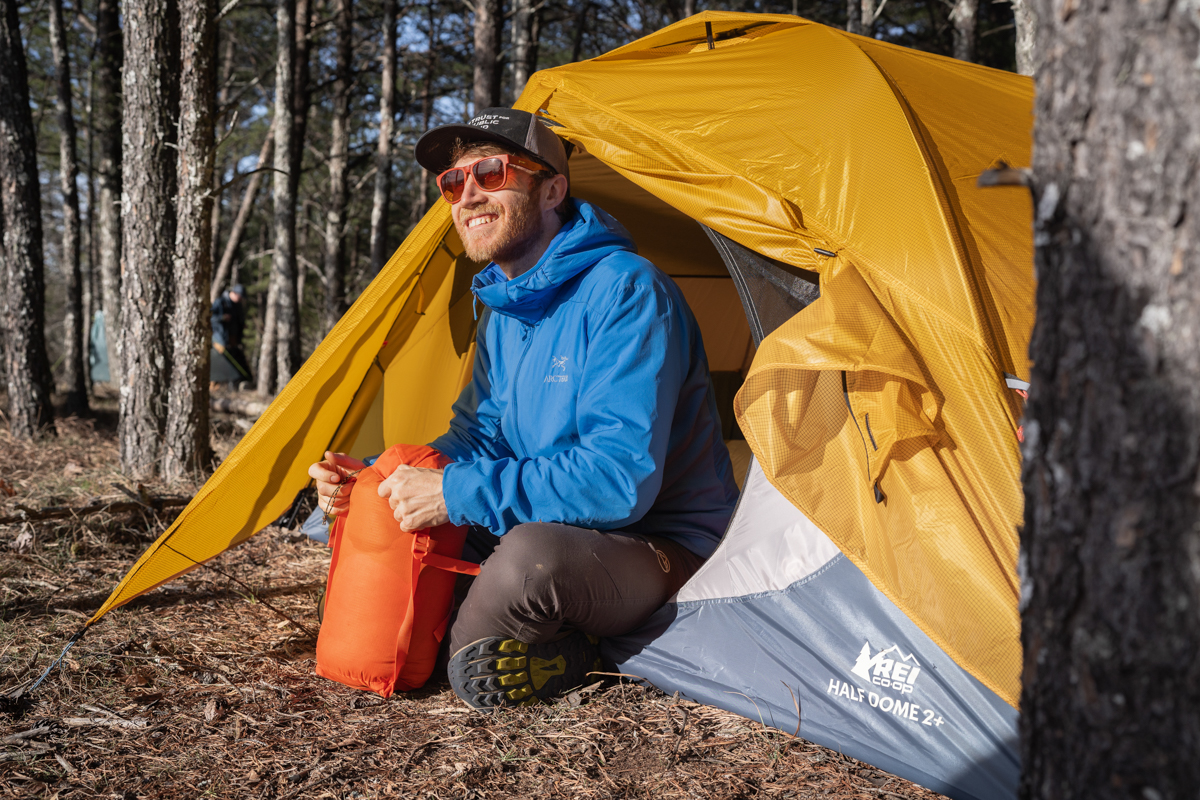
Nemo’s Aurora 2P and Big Agnes’ Salt Creek SL2 are two other models to consider. Starting with the Nemo, this tent follows a similar recipe as the Half Dome with a low price ($300), durable build (68D floor), and near-vertical walls, but it also gives up a bit of interior space (about 3 sq. ft.) in an effort to stay light (5 lb. 10.0 oz. packed). The Big Agnes costs $50 more than the Nemo but has an even lighter packed weight of 4 pounds 1 ounce. Though the Big Agnes is much smaller with a 28-square-foot interior that tapers at the foot end, serious backpackers will likely appreciate the weight savings. In the end, each tent has its pros and cons, so you'll want to evaluate your objectives and priorities before making a decision.
Back to the REI Half Dome 2 Plus Review See Our Backpacking Tents Guide